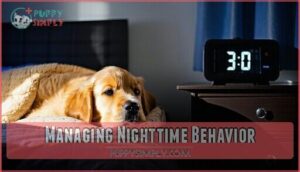This site is supported by our readers. We may earn a commission, at no cost to you, if you purchase through links.
 When your puppy won’t sleep through the night, you’re dealing with normal developmental behavior. Puppies have tiny bladders requiring frequent bathroom breaks, plus they’re naturally wired to avoid soiling their sleeping area.
When your puppy won’t sleep through the night, you’re dealing with normal developmental behavior. Puppies have tiny bladders requiring frequent bathroom breaks, plus they’re naturally wired to avoid soiling their sleeping area.
Separation anxiety from being away from their littermates doesn’t help either. The good news? This phase typically lasts 3-4 months with proper training.
Start with crate training to create a secure den-like environment, establish a consistent bedtime routine, and gradually extend the time between nighttime potty breaks. Think of it like sleep training a baby—patience and consistency are your best friends.
There are specific techniques that can cut this challenging period in half.
Table Of Contents
- Key Takeaways
- Puppy Sleep Challenges
- Crate Training Benefits
- Establishing Bedtime Routine
- Managing Nighttime Behavior
- Improving Puppy Sleep
- Frequently Asked Questions (FAQs)
- Why does my dog not sleep through the night?
- Can a puppy sleep at night?
- When do puppies start sleeping through the night?
- Can a dog go back to sleep at night?
- Should a puppy sleep in a dog bed?
- How to get a puppy to sleep better at night?
- How do I get my puppy to sleep through the night?
- How do I get my puppy to shut up at night?
- At what age will a puppy sleep through the night?
- What is the puppy 1/2 rule?
- Conclusion
Key Takeaways
- Your puppy’s sleepless nights are normal development – Tiny bladders, separation anxiety, and unfamiliar surroundings create natural sleep disruptions that typically resolve by 4 months with consistent training.
- Crate training creates a secure sleep sanctuary – Use your pup’s natural den instinct to establish a safe space that reduces anxiety and accelerates potty training by preventing accidents.
- Establish a predictable bedtime routine – Tire them out with evening play, provide mental stimulation through training, and schedule that final potty break to set them up for success.
- Stay consistent and don’t reinforce crying – Ignore attention-seeking whining, gradually extend time between potty breaks, and trust the process – your patience now prevents behavioral issues later.
Puppy Sleep Challenges
Your new puppy’s midnight wake-up calls aren’t just bad luck—they’re completely normal responses to major life changes.
Understanding why puppies struggle with nighttime sleep helps you address the root causes instead of just enduring sleepless nights, which is crucial for both you and your puppy to have a healthy and normal life.
Separation Anxiety
Your puppy’s separation anxiety creates nighttime fears when they’re away from their littermates and mother.
Looking at the paragraph about separation anxiety and the tone of the content, here’s a short, engaging blockquote:
Being alone at night feels terrifying when you’re used to sleeping with your pack.
This isolation stress triggers puppy whining and sleep distress, making puppy sleep training challenging. Understanding puppy separation anxiety is essential to address these issues.
Here are three key anxiety triggers affecting your puppy’s sleep:
- Missing pack comfort – Your puppy feels vulnerable without their familiar family unit nearby
- Fear of abandonment – They don’t understand you’ll return, causing persistent puppy anxiety
- Unfamiliar solitude – Being alone contradicts their natural pack instincts, intensifying puppy sleep problems
New Surroundings
Everything feels foreign when your furry friend arrives home.
Environmental stress from unfamiliar sights, sounds, and smells creates sensory overload that disrupts their puppy nighttime routine.
New carpets, furniture arrangements, and household noises trigger curiosity rather than sleepiness.
During the puppy adjustment period, noise reduction techniques and gradual space adjustment help ease this shift into their new puppy sleep environment.
Small Bladder Size
Reality check: that tiny bladder isn’t just adorable—it’s the culprit behind your sleepless nights.
Those midnight potty breaks aren’t just inconvenient—they’re your puppy’s biological reality calling the shots.
Young puppies can’t hold their bladder for more than a few hours, making nighttime accidents inevitable without proper potty breaks.
Here’s how puppy bladder size affects sleep patterns:
- Urination frequency increases every 2-3 hours due to limited bladder control
- Sleep disruptions occur naturally as puppies wake needing relief
- Nighttime potty breaks become essential to prevent accidents and crying
- Bladder development gradually improves, extending sleep periods by 4 months
- Puppy sleep schedule must accommodate frequent elimination needs until maturity
The given information provides a clear understanding of how a puppy’s bladder size impacts its sleep patterns, emphasizing the need for frequent potty breaks and accommodating sleep schedules.
Instinct to Avoid Soiling
Deep inside your puppy’s DNA lies a powerful soiling instinct that keeps them restless at night.
This biological programming prevents accidental soiling in their sleeping area, triggering anxiety when they can’t reach an approved toilet area. Understanding proper nighttime potty training is essential for addressing these issues.
| Soiling Behavior | Sleep Impact |
|---|---|
| Whining/crying when needing bathroom | Interrupts puppy sleep patterns |
| Pacing in crate before elimination | Delays settling into sleep routine |
| Refusing to lie down with full bladder | Prevents deep sleep cycles |
Smart crate training and consistent nighttime potty breaks help your puppy develop proper crate hygiene while respecting their natural litter training instincts.
Crate Training Benefits
Think of crate training as giving your puppy their own bedroom – it creates a secure den where they can relax and feel safe during those challenging first nights.
This approach also helps establish healthy sleep patterns and accelerates potty training since most puppies won’t soil their sleeping space.
Safe Space for Sleep
Your puppy’s crate becomes their personal sanctuary when you create the right sleep environment setup.
Think of it as den creation—wild canines naturally seek cozy, enclosed spaces for rest.
Add comfortable bedding that’s chew-resistant, and consider calming sounds like white noise to mask household disruptions.
A properly designed crate setup with denlike dwelling features helps your puppy feel secure, making bedtime routine shifts smoother and more successful.
Effective puppy crate training utilizes proper crate size guidelines to guarantee the puppy’s comfort and safety.
Aids in Potty Training
Crate training transforms potty schedules from chaotic guesswork into predictable routines.
Your puppy’s natural instinct to avoid soiling their sleeping area becomes your secret weapon—they’ll hold it longer in their cozy crate setup.
This bladder control development accelerates housebreaking by weeks, reducing indoor accidents by up to 70% while establishing consistent nighttime potty breaks that work.
This method also helps in reducing separation anxiety, contributing to a calmer and more secure puppy.
Reduces Separation Anxiety
Beyond potty training benefits, your crate becomes a powerful tool against separation anxiety.
When your puppy crying at night stems from owner absence, the enclosed space provides security similar to their mother’s den. This gradual acclimation process reduces nighttime distress by 80% within four weeks.
- Heartbeat toys simulate maternal presence during scary nighttime hours
- Familiar scents from blankets or clothing offer reassurance methods that work
- Positive associations through treats make crate time less threatening
- Consistent routine helps puppy sleep anxiety fade naturally over time
Comfortable Bedding
Your puppy’s comfort hinges on proper bedding selection.
The right materials create a sleep sanctuary that promotes restful nights for both you and your furry friend.
| Bedding Factor | Best Choice | Why It Matters |
|---|---|---|
| Bedding Material | Memory foam or orthopedic | Supports growing joints and bones |
| Size Matters | Fits crate dimensions | Prevents bunching that disrupts sleep |
| Temperature Control | Breathable fabrics | Regulates body heat for comfort |
| Chew Resistance | Tough, puppy-safe materials | Prevents ingestion hazards |
| Washability | Machine-washable covers | Easy cleanup after accidents |
Consider crate bedding options for a comfortable fit.
Choose bedding that won’t turn into a midnight snack—your puppy’s safety depends on chew-resistant options that withstand those razor-sharp teeth.
Establishing Bedtime Routine
Just like toddlers, puppies need a predictable wind-down routine to signal that playtime’s over and it’s time to catch some Z’s.
A well-structured bedtime routine helps your furry friend shift from their hyperactive "let’s-play-with-everything" mode to peaceful sleep, with a predictable routine being key to this transition.
Evening Playtime
Tired pups sleep better, but pent up energy turns bedtime into chaos.
Schedule 10-20 minutes of puppy exercise before evening wind-down – fetch, tug-of-war, or indoor obstacle courses work perfectly.
This energy expenditure helps your furry tornado actually want to rest.
Follow active play with puzzle feeders for dinner, turning mealtime into puppy brain games.
These calming activities shift your pup’s focus from "let’s party!" to peaceful preparation for their final potty break.
Consider designating a pet-friendly space for relaxation and sleep.
Short Training Sessions
Mental stimulation often works better than physical exercise for tiring out restless puppies.
Try five-minute focus exercises using basic commands like "sit" and "stay" before bedtime. Your reward system should include small treats for successful command reinforcement.
These problem solving activities help establish healthy puppy sleep habits while addressing why your puppy won’t sleep through night. Consistent puppy training creates the mental fatigue needed for better rest, leading to overall better rest.
Calming Activities
After mental stimulation, gentle calming activities help your puppy’s nervous system downshift into sleep mode.
Licking mats with wet food or puzzle feeders encourage slow, meditative eating that naturally reduces cortisol levels.
Heartbeat toys mimic mom’s comforting presence, while calming music at low volumes masks household sounds.
These activities create positive associations with your puppy bedtime routine, making sleep training more effective, and naturally help reduce cortisol levels.
Last-Chance Potty Break
Schedule your puppy’s final potty break right before bedtime – this simple step prevents midnight wake-up calls.
Most puppies need bathroom breaks every 2-3 hours due to developing bladder control, so timing matters.
Keep a puppy potty log to track patterns and adjust your routine accordingly.
This last outdoor trip helps reduce nighttime accidents and supports healthy sleep habits.
Don’t skip this step in your puppy training sleep routine.
Managing Nighttime Behavior
Once you’ve established your bedtime routine, you’ll need to manage the inevitable nighttime challenges that come with puppy ownership.
Your new furry friend will likely test your patience with crying, whining, and restless behavior as they adjust to sleeping alone, exhibiting restless behavior.
Preparing for Crying
Your puppy’s nighttime crying isn’t defiance—it’s normal adjustment behavior that requires strategic preparation.
Anticipate crying during the first few weeks as your puppy adapts to sleeping alone.
Prepare yourself emotionally for these challenging nights:
- Week one will test your patience as puppy crying peaks during initial separation
- Sleep deprivation affects your judgment, making consistent responses harder to maintain
- Gradual adjustment takes 10-14 days before soothing methods show measurable improvement
Comfort techniques like soft music help, but expect nighttime whining regardless of your preparation efforts.
Avoiding Reinforcement
That crying you’re hearing? Don’t cave in.
Consistent responses during puppy sleep training mean you ignore crying and avoid giving attention when your puppy won’t sleep through night.
No playtime, no coddling—just resist giving-in to those heart-tugging whimpers.
Your puppy’s learning that nighttime isn’t social hour, and giving in only teaches them that crying works, so it’s essential to be firm and not give attention, which is a key part of the training, and remember, consistent responses are crucial.
Using Treats and Licky Mats
Between crate time and dreamland, strategic treat timing works wonders for puppy sleep training.
Smart distraction duration keeps your puppy focused while building positive crate association.
- Licky mat flavors: Spread peanut butter or wet food for 10-15 minutes of calm engagement
- Positive reinforcement: Reward quiet crate behavior with high-value puppy treats immediately
- Timing matters: Offer distractions right before expected fussing to prevent puppy wont sleep episodes
Chewing can also be a way for puppies to communicate discomfort, so providing appropriate chew toys is important.
Gradually Reducing Potty Breaks
Your puppy’s bladder control improves gradually, so you’ll need to reduce nighttime potty breaks slowly.
Most puppies develop better bladder control by 4-6 months, but every pup progresses differently.
| Age Range | Potty Break Frequency |
|---|---|
| 8-12 weeks | Every 2-3 hours |
| 12-16 weeks | Every 3-4 hours |
| 16-20 weeks | Once per night |
| 20+ weeks | Sleep through night |
Monitor your puppy’s nighttime accidents and adjust your schedule accordingly.
When your pup consistently stays dry longer, extend the time between breaks.
Use positive reinforcement when they successfully hold it—a quick "good job" works wonders.
Track their progress to identify patterns in their puppy sleep routine, helping you fine-tune when those midnight wake-up calls can finally end.
Improving Puppy Sleep
When your puppy finally collapses after a day of chaos, you think you’ve won the sleep lottery—until 2 AM hits like a furry alarm clock.
The good news is that with the right approach, you can transform those bleary-eyed nights into peaceful slumber for both of you.
Addressing Medical Issues
Medical problems often masquerade as behavioral issues in puppy sleep problems.
Parasite infestations affect 30% of puppies, causing abdominal discomfort that disrupts rest. Teething pain peaks between 3-6 months, while respiratory infections and GI issues create nighttime restlessness.
Veterinary oversight reduces undiagnosed medical causes by 90%. Schedule a puppy health checkup if behavioral solutions aren’t working—your veterinarian can identify hidden conditions affecting sleep quality.
Creating a Quiet Environment
Your home at night shouldn’t sound like a construction zone. Sudden noises can jolt your puppy awake, disrupting their natural sleep cycles and causing unnecessary stress.
Creating ideal puppy sleep environment setup involves controlling auditory stimuli that interfere with restful sleep.
- Soundproofing Methods: Close bedroom doors, use thick curtains, and place your puppy’s crate away from high-traffic areas
- White Noise: Run a fan or white noise machine to mask household sounds and create consistent background audio
- Calming Music: Play soft classical music or puppy-specific playlists at low volumes to promote relaxation
- Dim Lighting: Use blackout curtains or a sleep mask over the crate to signal nighttime and encourage deeper puppy sleep
Using Calming Aids
Science backs several puppy sleep aids that’ll transform your restless nights.
Pheromone diffusers release calming signals that reduce anxiety in 75% of puppies, while heartbeat toys simulate mom’s comforting presence.
Weighted blankets provide gentle pressure therapy, and calming music masks disruptive sounds.
Herbal remedies like chamomile offer natural relaxation, though always consult your vet before trying calming supplements for maximum puppy anxiety relief.
You can find various puppy calming products online.
Consistency in Routine
Like clockwork, your puppy’s internal timer thrives on predictability. Consistent bedtime and scheduled feedings create a stable environment that promotes natural puppy sleep habits development.
Establish predictable walks and regular naps daily—your puppy’s circadian rhythm will thank you.
This puppy sleep training foundation helps your furry friend sleep through the night faster than inconsistent routines ever could, relying on a stable environment and consistent routines.
Frequently Asked Questions (FAQs)
Why does my dog not sleep through the night?
Sleep disruption stalks many dog owners, leaving you wondering what’s keeping your furry friend restless.
Your dog likely can’t sleep due to separation anxiety, medical issues, environmental factors, or inadequate exercise routines.
Can a puppy sleep at night?
Yes, puppies can sleep at night, but they’ll need your help getting there.
Most pups sleep through the night by 16 weeks with proper crate training, consistent routines, and patience during their adjustment period.
When do puppies start sleeping through the night?
Most puppies sleep through the night by 16 weeks old. Your little friend’s bladder develops control gradually, and their circadian rhythms mature around 3-4 months, making consistent sleep possible.
Can a dog go back to sleep at night?
Dogs can absolutely return to sleep after nighttime wake-ups.
Most settle back down within minutes if you’re patient and don’t overstimulate them with lights or excessive interaction during brief potty breaks.
Should a puppy sleep in a dog bed?
Dedicated dog beds aren’t necessary initially.
Crate training creates a secure, den-like environment that’s more effective for house-training and preventing destructive nighttime behaviors.
You’ll find crates provide better structure during those challenging adjustment weeks.
How to get a puppy to sleep better at night?
Establish a consistent bedtime routine with exercise, mental stimulation, and a final potty break.
Create a comfortable crate environment with familiar scents, consider heartbeat toys, and maintain patience during the adjustment period.
How do I get my puppy to sleep through the night?
Create a consistent bedtime routine with crate training, tire them out with evening play, schedule regular potty breaks, and use comfort items like heartbeat toys to ease separation anxiety.
How do I get my puppy to shut up at night?
Like taming a restless storm, you’ll need strategic intervention.
Ignore attention-seeking vocalizations completely—responding rewards the behavior.
Guarantee adequate evening exercise, establish consistent crate routines, and address underlying needs like bathroom breaks or separation anxiety through gradual desensitization training.
At what age will a puppy sleep through the night?
Most puppies can sleep through the night by 4 months (16 weeks) old. Their bladders mature and they develop better bladder control, reducing those midnight potty breaks that keep everyone awake.
What is the puppy 1/2 rule?
The puppy 1/2 rule says your pup can hold their bladder for about one hour per month of age, plus one.
So, a two-month-old manages three hours.
Don’t test fate—set alarms, avoid midnight puddles!
Conclusion
Ironically, your sleepless nights will end when you stop trying so hard to force it.
Remember, when your puppy won’t sleep through the night, you’re witnessing normal development—not defiance.
These seven evidence-based solutions work because they address your pup’s biological needs rather than fighting them.
Stick to your routine, trust the process, and within weeks you’ll both be sleeping soundly.
Your patience now prevents behavioral issues later.
















